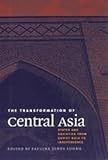The Transformation of Central Asia : States and Societies from Soviet Rule to Independence / ed. by Pauline Jones Luong.
Material type: TextPublisher: Ithaca, NY : Cornell University Press, [2018]Copyright date: ©2003Description: 1 online resource (352 p.) : 3 line drawings, 16 tables, 9 charts/graphs, 1 mapContent type:
TextPublisher: Ithaca, NY : Cornell University Press, [2018]Copyright date: ©2003Description: 1 online resource (352 p.) : 3 line drawings, 16 tables, 9 charts/graphs, 1 mapContent type: - 9781501731334
- 306/.0958 23
- HN670.22.A8 T73 2004eb
- online - DeGruyter
| Item type | Current library | Call number | URL | Status | Notes | Barcode | |
|---|---|---|---|---|---|---|---|
 eBook
eBook
|
Biblioteca "Angelicum" Pont. Univ. S.Tommaso d'Aquino Nuvola online | online - DeGruyter (Browse shelf(Opens below)) | Online access | Not for loan (Accesso limitato) | Accesso per gli utenti autorizzati / Access for authorized users | (dgr)9781501731334 |
Frontmatter -- Contents -- Acknowledgments -- List of Acronyms -- Introduction. Politics in the Periphery: Competing Views of Central Asian States and Societies -- PART I. THE RETREAT OF THE STATE: Women and the Social Sphere -- 1. Between Women and the State: Mahalia Committees and Social Welfare in Uzbekistan -- 2. Women, Marriage, and the Nation-State: The Rise of Nonconsensual Bride Kidnapping in Post -Soviet Kazakhstan -- PART 2: LINKING STATE AND SOCIETY: Culture and Language -- 3. Cultural Elites in Uzbekistan: Ideological Production and the State -- 4. A Shrinking Reach of the State? Language Policy and Implementation in Kazakhstan and Kyrgyzstan -- PART 3: THE STATE AGAINST ITSELF: Central-Regional Relations -- 5. The Limits of Centralization: Regional Challenges in Uzbekistan -- 6. Economic "Decentralization" in Kazakhstan: Causes and Consequences -- PART 4: REDEFINING THE STATE: Internal and External Forces -- 7. The Civic Realm in Kyrgyzstan: Soviet Economic Legacies and Activists' Expectations -- 8. Beyond the State: Transnational Actors, NGOs, and Environmental Protection in Central Asia -- Conclusion: Central Asia's Contribution to Theories of the State -- List of Foreign Words -- Bibliography -- Contributors -- Index
restricted access online access with authorization star
http://purl.org/coar/access_right/c_16ec
With the fall of the Soviet Union in 1991, former Communist Party leaders in Central Asia were faced with the daunting task of building states where they previously had not existed: Kazakhstan, Kyrgyzstan, Tajikistan, Turkmenistan, and Uzbekistan. Their task was complicated by the institutional and ideological legacy of the Soviet system as well as by a more actively engaged international community. These nascent states inherited a set of institutions that included bloated bureaucracies, centralized economic planning, and patronage networks. Some of these institutions survived, others have mutated, and new institutions have been created. Experts on Central Asia here examine the emerging relationship between state actors and social forces in the region. Through the prism of local institutions, the authors reassess both our understanding of Central Asia and of the state-building process more broadly. They scrutinize a wide array of institutional actors, ranging from regional governments and neighborhood committees to transnational and non-governmental organizations. With original empirical research and theoretical insight, the volume's contributors illuminate an obscure but resource-rich and strategically significant region.
Mode of access: Internet via World Wide Web.
In English.
Description based on online resource; title from PDF title page (publisher's Web site, viewed 26. Apr 2024)


